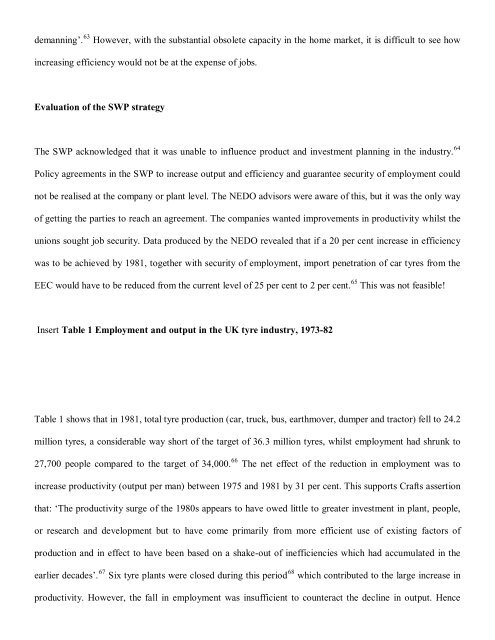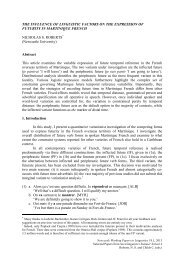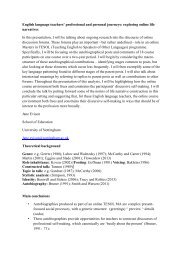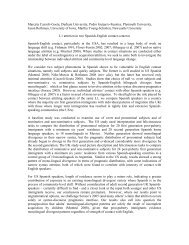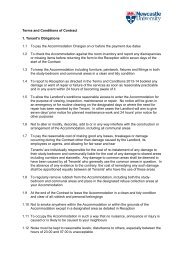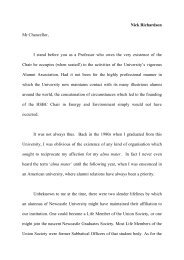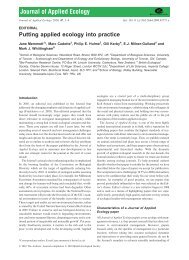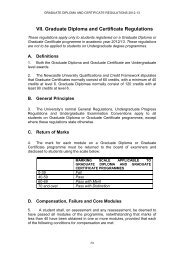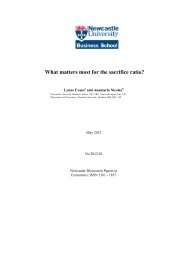The decline of the British tyre industry - Newcastle University
The decline of the British tyre industry - Newcastle University
The decline of the British tyre industry - Newcastle University
Create successful ePaper yourself
Turn your PDF publications into a flip-book with our unique Google optimized e-Paper software.
demanning’. 63<br />
However, with <strong>the</strong> substantial obsolete capacity in <strong>the</strong> home market, it is difficult to see how<br />
increasing efficiency would not be at <strong>the</strong> expense <strong>of</strong> jobs.<br />
Evaluation <strong>of</strong> <strong>the</strong> SWP strategy<br />
<strong>The</strong> SWP acknowledged that it was unable to influence product and investment planning in <strong>the</strong> <strong>industry</strong>. 64<br />
Policy agreements in <strong>the</strong> SWP to increase output and efficiency and guarantee security <strong>of</strong> employment could<br />
not be realised at <strong>the</strong> company or plant level. <strong>The</strong> NEDO advisors were aware <strong>of</strong> this, but it was <strong>the</strong> only way<br />
<strong>of</strong> getting <strong>the</strong> parties to reach an agreement. <strong>The</strong> companies wanted improvements in productivity whilst <strong>the</strong><br />
unions sought job security. Data produced by <strong>the</strong> NEDO revealed that if a 20 per cent increase in efficiency<br />
was to be achieved by 1981, toge<strong>the</strong>r with security <strong>of</strong> employment, import penetration <strong>of</strong> car <strong>tyre</strong>s from <strong>the</strong><br />
EEC would have to be reduced from <strong>the</strong> current level <strong>of</strong> 25 per cent to 2 per cent. 65<br />
This was not feasible!<br />
Insert Table 1 Employment and output in <strong>the</strong> UK <strong>tyre</strong> <strong>industry</strong>, 1973-82<br />
Table 1 shows that in 1981, total <strong>tyre</strong> production (car, truck, bus, earthmover, dumper and tractor) fell to 24.2<br />
million <strong>tyre</strong>s, a considerable way short <strong>of</strong> <strong>the</strong> target <strong>of</strong> 36.3 million <strong>tyre</strong>s, whilst employment had shrunk to<br />
27,700 people compared to <strong>the</strong> target <strong>of</strong> 34,000. 66 <strong>The</strong> net effect <strong>of</strong> <strong>the</strong> reduction in employment was to<br />
increase productivity (output per man) between 1975 and 1981 by 31 per cent. This supports Crafts assertion<br />
that: ‘<strong>The</strong> productivity surge <strong>of</strong> <strong>the</strong> 1980s appears to have owed little to greater investment in plant, people,<br />
or research and development but to have come primarily from more efficient use <strong>of</strong> existing factors <strong>of</strong><br />
production and in effect to have been based on a shake-out <strong>of</strong> inefficiencies which had accumulated in <strong>the</strong><br />
earlier decades’. 67 Six <strong>tyre</strong> plants were closed during this period 68 which contributed to <strong>the</strong> large increase in<br />
productivity. However, <strong>the</strong> fall in employment was insufficient to counteract <strong>the</strong> <strong>decline</strong> in output. Hence


